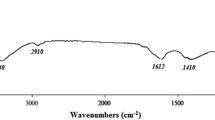Abstract
Microalgae Tetraselmis species were used to evaluate the biological characteristics of water-soluble polysaccharides (WSPs) as one of the significant bioactive substances (BAS) from these photosynthetic microalgae species. Compositional analysis of these BAS shows that they are mainly composed of WSPs along with negligible amount of proteins and lipids. WSPs were partially purified and characterized for their compositional, structural and biological properties such as antioxidant, tyrosinase inhibitory activity and antifungal activies. These WSPs showed the significant antioxidant, antifungal and tyrosinase inhibitory activities, respectively. The outcomes of this study demonstrated that WSPs can be the potent source of biological moieties for further investigations along with specific potent biological activities.





Similar content being viewed by others
Abbreviations
- WSP:
-
Water-soluble polysaccharides
- BAS:
-
Bioactive substances
- T1:
-
KCTC 12236BP
- T2:
-
KCTC 12432BP
- DPPH:
-
1,1-Diphenyl-2-picrylhydrazyl
- FRAP:
-
Ferric reducing antioxidant power
- ABTS:
-
2,2′-Azino-bis(3-ethylbenzothiazoline-6-sulfonic acid) di-ammonium salt TPTZ 2,4,6-tri(2-pyridyl)-s-triazine
- TLC:
-
Thin-layer chromatography
References
Wei L, Huang X, Huang Z (2014) Temperature effects on lipid properties of microalgae Tetraselmis subcordiformis and Nannochloropsis oculata as biofuel resources. Chin J Oceanol Limnol 33:99–106. https://doi.org/10.1007/s00343-015-3346-0
Chisti Y (2008) Biodiesel from microalgae beats bioethanol. Trends Biotechnol 26:126–131. https://doi.org/10.1016/j.tibtech.2007.12.002
Hung MT, Liu JC (2006) Microfiltration for separation of green algae from water. Colloids Surf B Biointerfaces 51:157–164. https://doi.org/10.1016/j.colsurfb.2006.07.003
Huntley ME, Johnson ZI, Brown SL et al (2015) Demonstrated large-scale production of marine microalgae for fuels and feed. Algal Res 10:249–265. https://doi.org/10.1016/j.algal.2015.04.016
Balen RE, Geraldo E, Luz Marques AEM et al (2015) Effect of defatted microalgae(Scenedesmus obliquus) biomass inclusion on growth performance of Rhamdia quelen (Quoy & Gaimard, 1824). J Appl Ichthyol 31:98–101. https://doi.org/10.1111/jai.12969
Arad S, Levy-Ontman O (2010) Red microalgal cell-wall polysaccharides: biotechnological aspects. Curr Opin Biotechnol 21:358–364. https://doi.org/10.1016/j.copbio.2010.02.008
Slominski A, Tobin DJ, Shibahara S, Wortsman J (2004) Melanin pigmentation in mammalian skin and its hormonal regulation. Physiol Rev 84:1155–1228. https://doi.org/10.1152/physrev.00044.2003
Hasegawa K, Fujiwara R, Sato K et al (2015) Possible involvement of keratinocyte growth factor in the persistence of hyperpigmentation in both human facial solar lentigines and melasma. Ann Dermatol 27:626–629. https://doi.org/10.5021/ad.2015.27.5.626
Sasaki M, Kondo M, Sato K et al (2014) Rhododendrol, a depigmentation-inducing phenolic compound, exerts melanocyte cytotoxicity via a tyrosinase-dependent mechanism. Pigment Cell Melanoma Res 27:754–763. https://doi.org/10.1111/pcmr.12269
Lee SY, Baek N, Nam T (2015) Natural, semisynthetic and synthetic tyrosinase inhibitors. J Enzyme Inhib Med Chem 00:1–13. https://doi.org/10.3109/14756366.2015.1004058
DuBois M, Gilles KA, Hamilton JK, Rebers PA and FS (1956) Colorimetric method for determination of sugars and related substances. Anal Chem 28:350–356. https://doi.org/10.1021/ac60111a017 doi
Hospital J (1944) METHOD NELSON for Medical. J Biol Chem 03:375–380
Geun Goo B, Baek G, Jin Choi D et al (2013) Characterization of a renewable extracellular polysaccharide from defatted microalgae Dunaliella tertiolecta. Bioresour Technol 129:343–350. https://doi.org/10.1016/j.biortech.2012.11.077
Lee CG, Lee J, Lee DG et al (2016) Immunostimulating activity of polyhydric alcohol isolated from Taxus cuspidata. Int J Biol Macromol 85:505–513. https://doi.org/10.1016/j.ijbiomac.2016.01.027
Bouzidi A, Benzarti A, Arem AE, Mahfoudhi A, Hammami S, Gorcii M, Mastouri M, Hellal AN, Zine M (2016) Chemical composition, antioxidant and antimicrobial effects of Tunisian Limoniastrum guyonianum Durieu ex Boiss extracts. Pak J Pharm Sci 4:1299–305
Hajimahmoodi M, Faramarzi MA, Mohammadi N et al (2010) Evaluation of antioxidant properties and total phenolic contents of some strains of microalgae. J Appl Phycol 22:43–50. https://doi.org/10.1007/s10811-009-9424-y
Bradford MM (1976) A rapid and sensitive method for the quantitation of microgram quantities of protein utilizing the principle of protein-dye binding. Anal Biochem 72:248–254. https://doi.org/10.1016/0003-2697(76)90527-3
Pérez-Palacios T, Ruiz J, Martín D et al (2008) Comparison of different methods for total lipid quantification in meat and meat products. Food Chem 110:1025–1029. https://doi.org/10.1016/j.foodchem.2008.03.026
Pourali A, Afrouziyeh M, Moghaddaszadeh-ahrabi S (2014) Extraction of phenolic composition and quantification of the total phenolic of pomegranate pomace. Eur J Exp Biol 4:174–176
Pomerantz SH (1966) The tyrosine hydroxylase activity of mammalian tyrosinase. J Biol Chem 241:161–168
Balouiri M, Sadiki M, Ibnsouda SK (2016) Methods for in vitro evaluating antimicrobial activity: a review. J Pharm Anal 6:71–79. https://doi.org/10.1016/j.jpha.2015.11.005
Yu D, Pu W, Li D et al (2016) Phenolic compounds and antioxidant activity of different organs of Potentilla fruticosa L. from two main production areas of China. Chem Biodivers 13:1140–1148. https://doi.org/10.1002/cbdv.201500512
Laurienzo P (2010) Marine polysaccharides in pharmaceutical applications: an overview. Mar Drugs 8:2435–2465. https://doi.org/10.3390/md8092435
Dewapriya P, Kim S (2014) Marine microorganisms: An emerging avenue in modern nutraceuticals and functional foods. Food Res Int 56:115–125. https://doi.org/10.1016/j.foodres.2013.12.022
Chen W, Zhang C, Song L et al (2009) A high throughput Nile red method for quantitative measurement of neutral lipids in microalgae. J Microbiol Methods 77:41–47. https://doi.org/10.1016/j.mimet.2009.01.001
Schwenzfeier A, Wierenga PA, Gruppen H (2011) Isolation and characterization of soluble protein from the green microalgae Tetraselmis sp. Bioresour Technol 102:9121–9127. https://doi.org/10.1016/j.biortech.2011.07.046
Bai MD, Cheng CH, Wan HM, Lin YH (2011) Microalgal pigments potential as byproducts in lipid production. J Taiwan Inst Chem Eng 42:783–786. https://doi.org/10.1016/j.jtice.2011.02.003
Benzie IFF, Strain JJ (1996) The ferric reducing ability of plasma (FRAP) as a measure of “antioxidant power”: the FRAP assay. Anal Biochem 239:70–76. https://doi.org/10.1006/abio.1996.0292
Macías AE, Ponce-De-León S (2005) Infection control: Old problems and new challenges. Arch Med Res 36:637–645. https://doi.org/10.1016/j.arcmed.2005.05.004
SB W, Mori M, MA P et al (1988) Hospital-acquired candidemia: The attributable mortality and excess length of stay. Arch Intern Med 148:2642–2645
Ghannoum MA, Rice LB (1999) Antifungal agents: mode of action, mechanisms of resistance, and correlation of these mechanisms with bacterial resistance. Clin Microbiol Rev 12:501–517. https://doi.org/10.1.1.322.6182
Acknowledgements
This research was supported by a grant from the Marine Biotechnology Program funded by the Ministry of Oceans and Fisheries.
Author information
Authors and Affiliations
Corresponding author
Ethics declarations
Conflict of interest
The authors report no conflicts of interest in this work.
Rights and permissions
About this article
Cite this article
Amna Kashif, S., Hwang, Y.J. & Park, J.K. Potent biomedical applications of isolated polysaccharides from marine microalgae Tetraselmis species. Bioprocess Biosyst Eng 41, 1611–1620 (2018). https://doi.org/10.1007/s00449-018-1987-z
Received:
Accepted:
Published:
Issue Date:
DOI: https://doi.org/10.1007/s00449-018-1987-z




